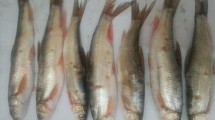Abstract
To investigate the health status, the parasite diversity and abundance were studied in three pike populations. For this purpose, totally 90 fish were caught from three natural habitats of pike including Chamkhale River, Anzali and Amirkelayeh wetlands, Iran. After biometry and age determination, fish were dissected and parasites were investigated in intestine, gill and eye. According to results, five parasite species were identified in whole body of pikes including Eustrongylides exises, Raphidascaris acus and Triaeophorus crassus in intestine, Tetraonchus monenteron in gill and Diplostomum spathaceum in eye. The highest values of quantitative indices of parasite population [i.e. incidence percent (86.66 %), mean intensity (60.83 ± 39.92), mean abundance (58.14 ± 34.6) and abundance range (1–232)] were recorded for T. monenteron in all three sampling regions. The lowest values of these quantitative indices were found for D. spathaceum, E. exises and Tetraonchus crassus in Anzali wetland, Chamkhale River and Amirkelayeh wetland respectively. In 2, 3 and 4 years old pikes, T. monenteron had the highest values of quantitative indices of parasite population. In conclusion, our results showed that Anzali wetland have more parasite pollution compared to other sampling regions. This may be due to the more rapid eutrophication in this wetland compared to Amirkelayeh wetland and Chamkhale River.

Similar content being viewed by others
References
Arai HP, Chien S-M (1973) A note on some Monogenea (Trematoda) from Albertan fishes. Can J Zool 51:1318
Barber I, Hoare D, Krause J (2000) Effects of parasites on fish behaviour: a review and evolutionary perspective. Rev Fish Biol Fisheries 10:131–165
Bush AO, Lafferty KD, Lotz JM, Shostak AW et al (1997) Parasitology meets ecology on its own terms: Margolis et al. revisited. J Parasitol 83:575–583
Karvonen A, Seppälä O, Valtonen ET (2004) Eye fluke-induced cataract formation in fish: quantitative analysis using an ophthalmological microscope. Parasitology 129:473–478
Kearn GC (1966) The adhesive mechanism of the monogenean parasite Tetraonchus monenteron from the gills of the pike (Esox lucius). Parasitology 56:505–510
Malek M, Mobedi I (2001) Occurrence of Clinostomum Complanatum(Rudolphi, 1819) (Digenea:Clinostomatidae) in Capoeta capoeta gracilis (Osteichthys: Cyprinidae) from Shiroud River, Iran. Iran J Public Health 30:95–98
May RM, Anderson RM (1979) Population biology of infectious disease. Nature 280:455–461
Moravec F, Frantova D (2003) Observations on the transmission and the seasonality of infection of the nematode Cystidicoloides ephemeridarum in Salmo trutta fario in a small trout stream in North Bohemia, the Czech Republic. Acta Parasitol 48:41–46
Nikolsky GV (1963) The ecology of fishes. Academic, London, p 352
Poulin R (1998) Evolutionary ecology of parasites: from individuals to communities. Chapman and Hall, London, p 212
Raat AJP (1998) Synopsis of biological data on the northern pike Esox lucius Linnaeus, 1758. FAO Fisheries Synopsis No. 30 Rev. 2. SAST - Pike - 1,24(03)001,01
Ramadan RAM (2012) Effect and Seasonal dynamics of Diplostomum spathaceum (eye fluke) on Oreochromis nilotcus at Abbassa Fish Farm, Egypt. Egypt J Aquac 2:105–113
Sattari M, Mokhayer B, Hasheminasab MF (2003) Parasites of Acipenser gueldenstaedti, A. nudiventris and huso huso (Chondrostei: Acipenseridae) from south-west of Caspian Sea (In Persian). J Vet Res 57:33–38
Smith JD (1984) Development of Raphidascaris acus (Nematoda, Anisakidae) in paratenic, intermediate, and definitive hosts. Can J Zool 62:1378–1386
Soylu E (2009) Monogenean parasites on the gills of some fish species from lakes Sapanca and Durusu, Turkey. E.U. J Fish Aquat Sci 26:247–251
Sutherland DR, Holloway HL Jr (1979) Parasites of fish from the Missouri, James, Sheyenne, and Wild Rice Rivers in North Dakota. Proc Helminthol Soc Wash 46:128–134
Voutilainen A, Figueiredo K, Huuskonen H (2008) Effects of the eye fluke Diplostomum spathaceum on the energetics and feeding of Arctic charr Salvelinus alpinus. J Fish Biol 73:2228–2237
Author information
Authors and Affiliations
Corresponding author
Rights and permissions
About this article
Cite this article
Sadrinejad, A., Khara, H. & Gudarzi, M. Investigation of parasites of pikes (Esox lucius Linnaeus, 1785) from Chamkhale River, Anzali and Amirkelayeh wetlands, Iran. J Parasit Dis 40, 1033–1037 (2016). https://doi.org/10.1007/s12639-014-0629-x
Received:
Accepted:
Published:
Issue Date:
DOI: https://doi.org/10.1007/s12639-014-0629-x




